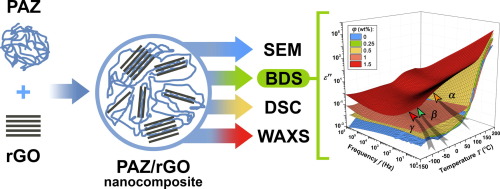当前位置:
X-MOL 学术
›
Eur. Polym. J.
›
论文详情
Our official English website, www.x-mol.net, welcomes your
feedback! (Note: you will need to create a separate account there.)
Relaxation processes in side-chain polyazomethine/thermally reduced graphene oxide nanocomposites
European Polymer Journal ( IF 5.8 ) Pub Date : 2017-11-01 , DOI: 10.1016/j.eurpolymj.2017.09.011 Sergei Bronnikov , Mihai Asandulesa , Sergei Kostromin , Aleksandr Podshivalov , Vasile Cozan
European Polymer Journal ( IF 5.8 ) Pub Date : 2017-11-01 , DOI: 10.1016/j.eurpolymj.2017.09.011 Sergei Bronnikov , Mihai Asandulesa , Sergei Kostromin , Aleksandr Podshivalov , Vasile Cozan

|
Abstract Nanocomposites based on side-chain polyazomethine (PAZ) and reduced graphene oxide (rGO) were prepared by solution blending method. They were subjected to broadband dielectric spectroscopy (BDS) analysis to discover the filler effect on the molecular mobility of the polymer chains. Low-temperature non-cooperative local γ - and β -relaxations and a high-temperature cooperative segmental α -relaxation were found and described analytically. The increasing rGO content was shown to retard all kinds of the molecular mobility of the PAZ chains. Because of enhanced attractive rGO/polymer segments interaction and retarded α -relaxation, the polymer fragility m and the dielectric glass transition temperature T g 100 of the PAZ/rGO nanocomposite were found to increase strongly with increasing rGO loading φ up to 1 wt%. However, when φ exceeds 1 wt%, the rGO nanoparticles form the percolation network resulting in enhanced conductivity of the nanocomposite and weakening the rGO/polymer segments interaction. As a consequence, m decreases and T g 100 tends to decline towards the value of the pristine PAZ. The dielectric relaxation strength was found to increase with increasing φ because of the rGO increment to the total dipole moment of the nanocomposite. Meanwhile, the thermal relaxation strength evaluated from the differential scanning calorimetry (DSC) data was shown to demonstrate other behavior. It decreases dramatically at a low rGO content ( φ . This finding confirms the polymer chains intercalation into the rGO stacks in PAZ/rGO nanocomposites.
中文翻译:

侧链聚偶氮甲碱/热还原氧化石墨烯纳米复合材料的松弛过程
摘要 采用溶液共混法制备了基于侧链聚偶氮甲碱(PAZ)和还原氧化石墨烯(rGO)的纳米复合材料。他们进行了宽带介电光谱 (BDS) 分析,以发现填料对聚合物链分子迁移率的影响。发现并分析描述了低温非合作局部γ-和β-弛豫以及高温合作分段α-弛豫。增加的 rGO 含量被证明会阻碍 PAZ 链的各种分子运动。由于增强的 rGO/聚合物链段相互作用和延迟的 α-弛豫,发现 PAZ/rGO 纳米复合材料的聚合物脆性 m 和介电玻璃化转变温度 T g 100 随着 rGO 负载 φ 增加至 1 wt% 而强烈增加。然而,当 φ 超过 1 wt% 时,rGO 纳米粒子形成渗透网络,导致纳米复合材料的导电性增强并减弱了 rGO/聚合物链段的相互作用。因此,m 降低,T g 100 趋向于向原始 PAZ 的值下降。发现介电弛豫强度随着 φ 的增加而增加,因为 rGO 增加了纳米复合材料的总偶极矩。同时,根据差示扫描量热法 (DSC) 数据评估的热松弛强度显示出其他行为。它在低 rGO 含量 ( φ ) 下急剧下降。这一发现证实了聚合物链嵌入 PAZ/rGO 纳米复合材料中的 rGO 堆叠中。
更新日期:2017-11-01
中文翻译:

侧链聚偶氮甲碱/热还原氧化石墨烯纳米复合材料的松弛过程
摘要 采用溶液共混法制备了基于侧链聚偶氮甲碱(PAZ)和还原氧化石墨烯(rGO)的纳米复合材料。他们进行了宽带介电光谱 (BDS) 分析,以发现填料对聚合物链分子迁移率的影响。发现并分析描述了低温非合作局部γ-和β-弛豫以及高温合作分段α-弛豫。增加的 rGO 含量被证明会阻碍 PAZ 链的各种分子运动。由于增强的 rGO/聚合物链段相互作用和延迟的 α-弛豫,发现 PAZ/rGO 纳米复合材料的聚合物脆性 m 和介电玻璃化转变温度 T g 100 随着 rGO 负载 φ 增加至 1 wt% 而强烈增加。然而,当 φ 超过 1 wt% 时,rGO 纳米粒子形成渗透网络,导致纳米复合材料的导电性增强并减弱了 rGO/聚合物链段的相互作用。因此,m 降低,T g 100 趋向于向原始 PAZ 的值下降。发现介电弛豫强度随着 φ 的增加而增加,因为 rGO 增加了纳米复合材料的总偶极矩。同时,根据差示扫描量热法 (DSC) 数据评估的热松弛强度显示出其他行为。它在低 rGO 含量 ( φ ) 下急剧下降。这一发现证实了聚合物链嵌入 PAZ/rGO 纳米复合材料中的 rGO 堆叠中。











































 京公网安备 11010802027423号
京公网安备 11010802027423号